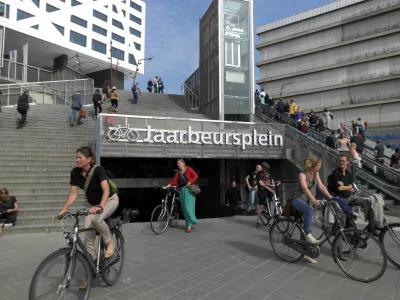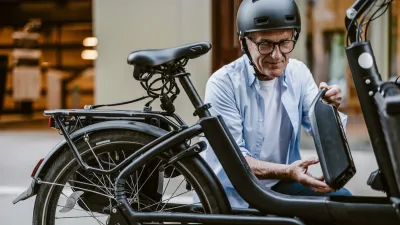Safe, protected bike lanes are a key part of a city’s bike infrastructure — but secure parking, e-bike charging, and other amenities can also influence people’s shift to cycling.

In a webinar hosted by Cycling Industries Europe (CIE), bike industry leaders discussed the barriers to higher adoption of cycling that are present in the “last 50 meters” of a trip.
As William Thorpe explains in an article for Cities Today, this includes a lack of infrastructure such as secure bike parking and e-bike chargers, which can make a trip easier and safer for riders. “While charging solutions dominated, LumiGuide made the case that better data and visibility can ease pressure on city planners. The Dutch firm has installed AI-powered bicycle parking detection systems in Utrecht, Paris and Amsterdam, including the latter’s new 7,000-bike underwater garage.”
An Italian company explained how they used financial incentives to nudge people to bike more often. According to Pin Bike CCO Riccardo Meo Evoli, “We’ve seen 10 percent modal shifts in some cities, and the behaviour sticks.”
Thorpe concludes, “Despite different solutions, the panellists were unified on two points: that interoperability and collaboration are key, and that policymakers should stop thinking in silos. As e-bike uptake accelerates, the panellists argued, planning must go beyond lanes and extend into secure parking, charging access, and digital integration across MaaS platforms.”
FULL STORY: ‘Last 50 metres’ now key to cycling modal shift

Planetizen Federal Action Tracker
A weekly monitor of how Trump’s orders and actions are impacting planners and planning in America.

Congressman Proposes Bill to Rename DC Metro “Trump Train”
The Make Autorail Great Again Act would withhold federal funding to the system until the Washington Metropolitan Area Transit Authority (WMATA), rebrands as the Washington Metropolitan Authority for Greater Access (WMAGA).

The Simple Legislative Tool Transforming Vacant Downtowns
In California, Michigan and Georgia, an easy win is bringing dollars — and delight — back to city centers.

Demise of Entertainment Industry Mirrors Demise of Housing in LA
Making movies has a lot in common with developing real estate: producers = developers; screenwriters = architects; directors = general contractors. The similarities are more than trivial. Both industries are now hurting in L.A.

How Public Spaces Exclude Teen Girls
Adolescent girls face unique challenges and concerns when navigating public spaces. We can design cities with their needs in mind.

Proposed Ohio Budget Preserves Housing Trust Fund
The Senate-approved budget also creates two new programs aimed at encouraging housing construction.
Urban Design for Planners 1: Software Tools
This six-course series explores essential urban design concepts using open source software and equips planners with the tools they need to participate fully in the urban design process.
Planning for Universal Design
Learn the tools for implementing Universal Design in planning regulations.
Smith Gee Studio
City of Charlotte
City of Camden Redevelopment Agency
City of Astoria
Transportation Research & Education Center (TREC) at Portland State University
US High Speed Rail Association
City of Camden Redevelopment Agency
Municipality of Princeton (NJ)





























